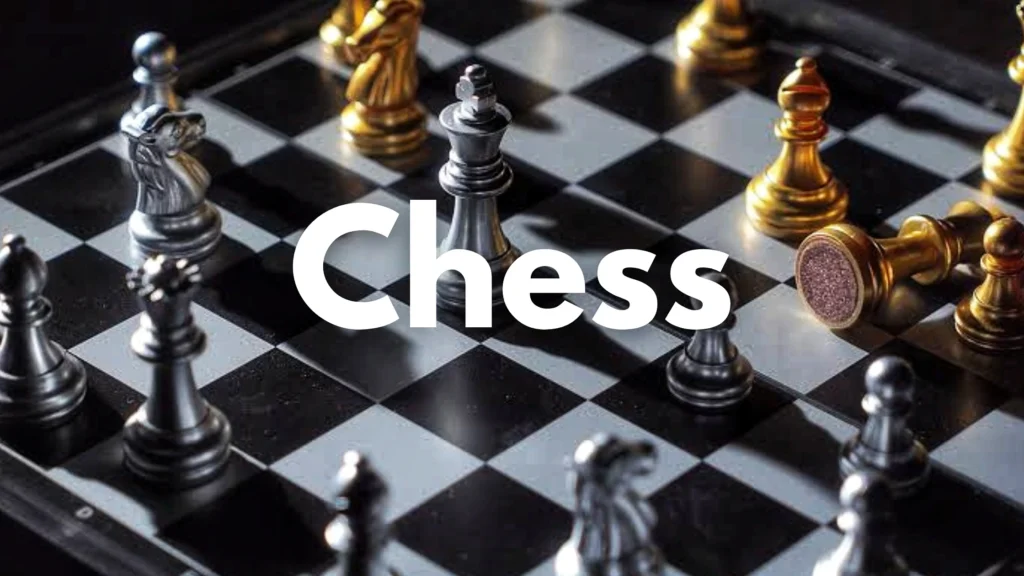Chess is one of the most revered and intellectually stimulating games ever created. Played on an 8×8 board with 64 squares, chess is a battle of strategy, foresight, and tactical execution between two opponents. This timeless board game has fascinated players for centuries, evolving from its ancient origins to become one of the most popular and competitive games worldwide.
A Brief History of Chess
Chess traces its origins back to India around the 6th century AD, where it was known as “Chaturanga.” This early form of the game gradually spread to Persia and then to Europe through trade and conquest. By the Middle Ages, chess had become a prominent fixture in European society, with evolving rules and increased strategic depth. The modern version of chess as we know it today took shape in the 15th century, with standardized rules that laid the foundation for competitive play.
Controls
In traditional chess, players move pieces manually on a physical board. In digital versions, such as online chess platforms or video game adaptations, players use:
- Mouse Clicks – Select and move pieces by clicking on them and choosing a destination square.
- Keyboard Shortcuts – Some platforms allow quick movements using keys for navigation.
- Touchscreen Controls – Mobile versions enable dragging and dropping pieces with a finger.
- Voice Commands – Some AI-assisted chess games allow moves via voice recognition.
How to Play
- Setup the Board – Place all pieces in their standard starting positions.
- Decide Who Goes First – The player with white pieces makes the first move.
- Move Pieces Strategically – Use the unique movement patterns of each piece to control the board.
- Develop a Strategy – Protect your king while attacking your opponent’s weaknesses.
- Check and Checkmate – Aim to put your opponent’s king in checkmate, meaning they have no legal moves to escape.
- Resign or Draw – If a player is in an unwinnable position, they may resign, or the game can end in a draw under certain conditions.
Understanding the Chessboard and Pieces
Chess is played on a checkered board with alternating light and dark squares. Each player starts with 16 pieces:
- 1 King – The most crucial piece; checkmate means the game is over.
- 1 Queen – The most powerful piece, capable of moving in any direction.
- 2 Rooks – Strong in open positions, moving horizontally and vertically.
- 2 Bishops – Diagonal movers that can control large areas of the board.
- 2 Knights – Unique L-shaped movers that can jump over other pieces.
- 8 Pawns – The smallest but crucial pieces that can promote to any other piece upon reaching the opponent’s back rank.
Rules and Objective of Chess
The objective of chess is to checkmate the opponent’s king, meaning it is under attack with no legal move to escape. Players take turns moving their pieces strategically to gain control of the board while defending their own king. Castling, en passant, and pawn promotion are essential rules that add complexity to the game.
Chess Openings: Setting the Stage for Victory
Opening strategy is a vital part of chess, where players aim to control the center, develop their pieces, and ensure king safety. Some famous chess openings include:
- Ruy-Lopez – A classic opening that prioritizes piece development and control of the center.
- Sicilian Defense – A counter-attacking opening often used by Black to gain an early advantage.
- French Defense – A solid, defensive opening that leads to strategic battles.
- King’s Gambit – A daring opening that sacrifices material for rapid development.
Middle Game Strategies: Gaining Tactical and Positional Advantage
Once the pieces are developed, players transition into the middle game, where tactics and strategy come into play. Key concepts include:
- Piece Coordination – Ensuring all pieces work together harmoniously.
- Pawn Structures – Understanding weak pawns, isolated pawns, and passed pawns.
- Forks, Pins, and Skewers – Tactical motifs that can help gain material advantage.
- Controlling Open Files – Dominating key lines on the board to increase influence.
Endgame Techniques: The Final Push for Victory
In the endgame, fewer pieces remain, making king activity crucial. Some essential endgame techniques include:
- King Centralization – Bringing the king into action to support pawn promotion.
- Pawn Promotion – Advancing a pawn to become a queen for a decisive advantage.
- Opposition and Zugzwang – Using positional advantages to force the opponent into losing moves.
- Basic Checkmating Patterns – Knowing how to checkmate with a king and queen or king and rook.
The Rise of Online Chess and Competitive Play
With the digital age, chess has gained massive popularity through online platforms like Chess.com, Lichess, and the Internet Chess Club. Chess tournaments, including the FIDE World Chess Championship and the Chess Olympiad, attract millions of viewers globally. The rise of chess influencers and grandmasters streaming on platforms like Twitch and YouTube has also contributed to a surge in new players.
Benefits of Playing Chess
Chess is more than just a game—it sharpens the mind and enhances cognitive abilities. Some of the key benefits of playing chess include:
- Improved Critical Thinking – Encourages logical reasoning and problem-solving skills.
- Enhanced Memory and Concentration – Boosts focus and recall abilities.
- Better Strategic Planning – Develops long-term thinking and decision-making.
- Stress Reduction – A great way to relax and engage in intellectual stimulation.

Conclusion
Chess remains a game of intellect, patience, and skill, enjoyed by millions worldwide. Whether played casually among friends, in school programs, or in high-stakes tournaments, chess continues to captivate minds of all ages. With the accessibility of online chess platforms, anyone can learn, practice, and compete, ensuring that this timeless strategy game will continue to thrive for generations to come.
For more information, please visit: www.gamesplayland.com
